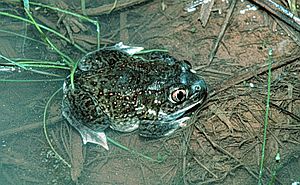Plains Spadefoot Toad facts for kids
Quick facts for kids Plains Spadefoot Toad |
|
|---|---|
 |
|
| Conservation status | |
| Scientific classification | |
| Kingdom: | |
| Phylum: | |
| Class: | |
| Order: | |
| Suborder: | |
| Family: | |
| Genus: |
Spea
|
| Species: |
S. bombifrons
|
| Binomial name | |
| Spea bombifrons (Cope, 1863)
|
|
| Synonyms | |
The plains spadefoot toad (Spea bombifrons) is a special kind of spadefoot toad. These amazing amphibians live in dry areas across southwestern Canada, the Great Plains of the United States, and northern Mexico. They are named for their unique "spades" on their back feet. These spades help them dig quickly into the ground.
Contents
About the Plains Spadefoot Toad
Plains spadefoot toads are known for their ability to survive in tough, dry places. Unlike many frogs that need constant water, these toads are experts at living in deserts and grasslands. They spend most of their lives underground, waiting for rain. When it rains, they come out to find food and reproduce.
What They Look Like
Plains spadefoot toads are usually small to medium-sized. They grow to be about 4 to 6 centimeters (1.5 to 2.5 inches) long. Their skin is smooth and can be gray, brown, or olive green. They often have darker spots or stripes on their backs. Their eyes have vertical pupils, which look like a cat's eye. This helps them see well in low light.
Their Special Feet
The most unique part of a plains spadefoot toad is its feet. On each back foot, they have a hard, sharp bump. This bump looks like a tiny spade or shovel. They use these spades to dig backwards into the soil. They can bury themselves very quickly, sometimes in less than a minute! This helps them escape from predators and the hot sun.
Where They Live
These toads are found in a wide area of North America. Their home includes the dry prairies and grasslands. You can find them in parts of Canada, many states in the central U.S., and northern Mexico. They prefer sandy or loose soil. This kind of soil is easy for them to dig into.
Their Habitat
Plains spadefoot toads live in places with hot summers and cold winters. They need areas where temporary pools of water form after heavy rains. These temporary ponds are very important for their babies. They are often found in open fields, prairies, and even some farmlands.
Life Cycle and Reproduction
The life cycle of the plains spadefoot toad is very fast. This is because they depend on rain. When a big rainstorm happens, hundreds of toads come out of the ground. They quickly find a temporary pond to lay their eggs.
Breeding After Rain
When the rain falls, male toads start calling loudly. Their calls sound like a low, raspy snore. Females are attracted to these calls. They meet at the temporary ponds. The female lays her eggs in long strings. These strings are attached to plants or other things in the water. A single female can lay thousands of eggs.
Tadpole Development
The eggs hatch very quickly, sometimes in just a day or two. The baby toads, called tadpoles, grow incredibly fast. They must change into adult toads before the temporary pond dries up. This can take as little as two weeks! They eat tiny plants and other small things in the water. If food is scarce, some tadpoles might even eat other tadpoles. This helps them grow faster.
Becoming Adult Toads
Once the tadpoles grow legs and lose their tails, they become tiny toadlets. These young toads then leave the pond. They dig into the ground, just like their parents. They will stay underground until the next big rain. This amazing speed helps them survive in their challenging environment.
How They Survive Dry Times
Plains spadefoot toads are experts at surviving long periods without water. This is called estivation. When the weather is dry, they dig deep into the soil. They can go down as far as 1 meter (3 feet).
Underground Living
While underground, they create a special "cocoon" around themselves. This cocoon is made of their own shed skin. It helps to keep moisture inside their bodies. They slow down their body functions. This means they use very little energy. They can stay buried for many months, sometimes even a year or more. They wait for the sound and feel of rain. When the ground gets wet enough, they know it's time to come out.
What They Eat
Plains spadefoot toads are carnivores, meaning they eat meat. They mostly eat insects and other small creatures.
Their Diet
When they are active above ground, they hunt for food. Their diet includes beetles, ants, spiders, crickets, and moths. They use their sticky tongues to catch their prey. Tadpoles, on the other hand, usually eat tiny plants and algae in the water.
See also
 In Spanish: Spea bombifrons para niños
In Spanish: Spea bombifrons para niños


